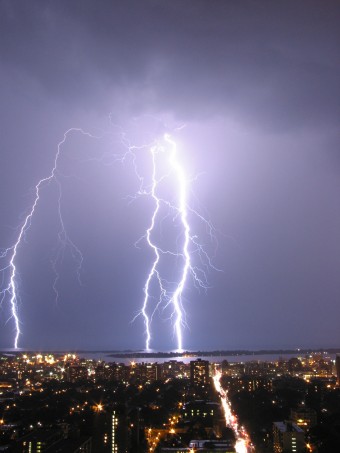A Jiffy is Used as an Actual Unit of Time
 Today I found out a ‘jiffy’ is used as an actual unit of time.
Today I found out a ‘jiffy’ is used as an actual unit of time.
The word ‘jiffy’ has been around since at least the late 18th century. What it derived from is unknown, but it first popped up as a “thieves slang for ‘lightning'”. Fast forward about a century and a half later and famed Physical Chemist Gilbert Newton Lewis, who incidentally came up with the word ‘photon’, suggested a ‘jiffy’ should be officially defined as the time it takes for light to travel one centimeter in a vacuum (about 33.3564 picoseconds). Since then, others in physics and chemistry have suggested alternative distances to measure a jiffy over, rather than light traveling for a centimeter, but the original value is still most typically used in physics and chemistry. Someone should get Jiffy Lube for false advertising!
The term ‘jiffy’ has branched out to mean different time values in other fields than it does in physics and chemistry. In computer science, for instance, what a jiffy precisely defines time-wise is tied to timer interrupts, defined as “the duration of one tick of a timer interrupt”. Obviously this varies from system to system, but usually is between 1-10 ms, with the commonly held value being 10 ms.
For electrical engineers, jiffy originally had a different meaning than today, relating to alternating currents. Specifically, it was .0167 or .02 seconds, which is the time between AC power cycles (.0167 seconds for the United States and .02 seconds in Europe). However, today it usually just means .01 seconds (10 ms), as with computer science, but in this case for no particular reason other than that’s the resolution of most common stopwatches.
With Jiffy Lube, ‘jiffy’ apparently means about 4800 seconds (80 minutes), which was the approximate amount of time it took them to change my oil last time I went there, with emphasis on “last time”. 😉
Bonus Facts:
- Dr. Gilbert Lewis not only came up with the word ‘photon’ and the official definition of ‘jiffy’ in physics and chemistry, but he also was nominated for a Nobel Prize 35 times, though never won a single one, something which rankled him to no end. Among many other things, he: derived the mass-energy relationship in 1908, in a different way than Albert Einstein, and did significant work in relativity; was the first to develop a method of purifying “heavy water” (deuterium oxide); discovered the covalent bond; reformed chemical thermodynamics to make it easier for ‘normal’ chemists to understand; and applied synthetic geometry to space-time, among other things.
- It has been speculated that Lewis’ death was not an accident, but rather was suicide. On the day of his death, he received an honorary degree from Berkeley and then met his longtime rival, Irving Langmuir, (1932 Nobel Prize winner) for lunch. Langmuir had expanded on Lewis’ chemical bond theory and won a Nobel Prize partially for this, with Lewis again getting the snub from the Nobel Prize voters. After he returned from his lunch, Lewis’ associates stated that he was in a very somber and cantankerous mood. He was found dead shortly thereafter in his lab. At the time, he was experimenting with liquid hydrogen cyanide, so the death was originally ruled to have been an accident, but many of his colleagues, such as Professor William Jolly, stated they thought it was suicide.
- Lewis was again snubbed by Nobel Prize voters when one of his students, Harold Urey, won a Nobel Prize in 1934 for the discovery of deuterium. Lewis felt that he should have been a co-winner due to the significant amount of work he did in the same area, around the same time, such as developing the method of purifying deuterium oxide and studying various characteristics of it.
- Lewis was the mentor to famed chemist Glenn T. Seaborg, who went on to win a 1951 Nobel Prize in Chemistry. Seaborg also had the element Seaborgium named after him. Apparently it was good to be a student of Dr. Lewis.
- Lewis coined the word ‘photon’ in 1926. Interestingly, he was proposing it not to describe the smallest unit of light as we think of it today, but of a non-energy, ‘indestructibly’ structural element of light. This obviously was completely incorrect and different than Einstein’s quantum theory of light, which Einstein not imaginatively called a “light quantum”. Apparently others thought Lewis’ name was better, even though he was wrong in his theory, because the word ‘photon’ got adopted instead.
- Lewis thought up ‘photon’ based on the Greek word for light, phôs.
- Another word Lewis came up with that got adopted was ‘fugacity’ to describe “the vapor pressure of a vapor assumed to be an ideal gas obtained by correcting the determined vapor pressure and useful as a measure of the escaping tendency of a substance from a heterogeneous system.”
| Share the Knowledge! |
|





This website is impossible to read. What a waste of a URL.
Place the focus of your eyesight on just one little bit of info:
“….today it usually just means .01 seconds.”
That’s right class: jiffy = 1/100th of a second.
The difficulty of Chinese algebra has reached it’s time limit AND it’s destination LOLOL